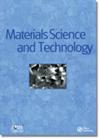Effect of Fe addition on phase evolution, microstructure and properties of Ti50Ni50-XFeX alloy
IF 2.2
4区 材料科学
Q3 MATERIALS SCIENCE, MULTIDISCIPLINARY
引用次数: 1
Abstract
The work aims to study the effect of the Fe content on the properties of Ti50 Ni(50−X) Fe X alloy (where X = 0, 2, 4, 6, 8, and 10 at.-%) sintered at 1050°C and 1150°C using the conventional sintering technique. The microstructure, chemical composition and phase evolution of the sample were analysed by SEM, EDS, and XRD, respectively, along with various properties. It was observed that the sintered sample microstructure consists of (Ni, Fe)-rich, and Ti-rich phases. Here, the porosity decreases, whereas density, hardness, and wear resistance increase with the increasing temperature. The 8at.-%Fe sample shows lower porosity and higher wear resistance, relative density and hardness value than other Fe content samples. The 2at.-%Fe sample sintered at 1050°C shows a higher shape recovery value compared to other compositions sintered at various temperatures.添加铁对Ti50Ni50-XFeX合金相演化、组织和性能的影响
本文章由计算机程序翻译,如有差异,请以英文原文为准。
求助全文
约1分钟内获得全文
求助全文
来源期刊

Materials Science and Technology
工程技术-材料科学:综合
CiteScore
2.70
自引率
5.60%
发文量
0
审稿时长
3 months
期刊介绍:
《Materials Science and Technology》(MST) is an international forum for the publication of refereed contributions covering fundamental and technological aspects of materials science and engineering.
 求助内容:
求助内容: 应助结果提醒方式:
应助结果提醒方式:


